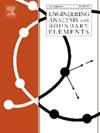A cell-based smoothed radial point interpolation method applied to lower bound limit analysis of thin plates
IF 4.2
2区 工程技术
Q1 ENGINEERING, MULTIDISCIPLINARY
Engineering Analysis with Boundary Elements
Pub Date : 2025-01-24
DOI:10.1016/j.enganabound.2025.106123
引用次数: 0
Abstract
This paper proposes a novel numerical method based on the cell-based smoothed radial point interpolation method (CS-RPIM) combined with second-order cone programming to perform lower bound limit analysis of elastic-perfectly-plastic thin plates, using only deflection as nodal variable. The problem domain is initially discretized using a simple triangular background mesh, where each triangular cell is subsequently subdivided into multiple smoothing domains. Shape functions are formulated using the radial point interpolation method, allowing direct imposition of essential boundary conditions for deflection. Rotational constraints are conveniently handled through the construction of smoothed curvatures. By utilizing a generalized gradient smoothing technique, complex domain integrals are simplified into boundary integrals over the smoothing domains, thus eliminating the need to compute second-order derivatives of the shape functions. The virtual work principle is employed to enforce the equilibrium conditions for the self-equilibrated residual moment field in a weak sense. The von Mises yield conditions are expressed as conic constraints and the resulting optimization problems are solved using highly efficient primal-dual interior point solvers. Numerical examples demonstrate that it is feasible and effective to conduct lower bound limit analysis of thin plates using the proposed CS-RPIM and second-order cone programming.
求助全文
约1分钟内获得全文
求助全文
来源期刊

Engineering Analysis with Boundary Elements
工程技术-工程:综合
CiteScore
5.50
自引率
18.20%
发文量
368
审稿时长
56 days
期刊介绍:
This journal is specifically dedicated to the dissemination of the latest developments of new engineering analysis techniques using boundary elements and other mesh reduction methods.
Boundary element (BEM) and mesh reduction methods (MRM) are very active areas of research with the techniques being applied to solve increasingly complex problems. The journal stresses the importance of these applications as well as their computational aspects, reliability and robustness.
The main criteria for publication will be the originality of the work being reported, its potential usefulness and applications of the methods to new fields.
In addition to regular issues, the journal publishes a series of special issues dealing with specific areas of current research.
The journal has, for many years, provided a channel of communication between academics and industrial researchers working in mesh reduction methods
Fields Covered:
• Boundary Element Methods (BEM)
• Mesh Reduction Methods (MRM)
• Meshless Methods
• Integral Equations
• Applications of BEM/MRM in Engineering
• Numerical Methods related to BEM/MRM
• Computational Techniques
• Combination of Different Methods
• Advanced Formulations.
 求助内容:
求助内容: 应助结果提醒方式:
应助结果提醒方式:


